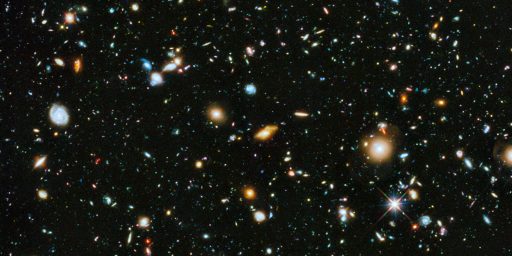Earth Sized Planet Discovered 4.3 Light Years Away
Scientists have found an Earth-sized planet only 4.3 light years away:
Bringing the search for another Earth about as close as it will ever get, a team of European astronomers was scheduled to announce on Wednesday that it had found a planet the same mass as Earth’s in Alpha Centauri, a triple star system that is the Sun’s closest neighbor, only 4.4 light-years away.
The planet is the lightest one ever found orbiting another star and — in the words of its discoverer, Xavier Dumusque, a graduate student at the Geneva Observatory — “it will surely be the closest one ever.”
It is presumably a rocky ball like our own, but it is not habitable. It circles Alpha Centauri B, a reddish orb about half as luminous as the Sun, every three days at a distance of only about four million miles, resulting in hellish surface temperatures of 1,200 degrees.
So this is not “Earth 2.0.” Yet.
Astronomers said the discovery raised the possibility that there were habitable Earthlike planets right next door and that methods and instruments were now precise enough to detect them.
“Very small planets are not rare,” said Mr. Dumusque, who is the lead author of a paper being published on Wednesday in Nature. “When you find one small planet, you find others.” He and his colleagues discussed the results on Tuesday in a news conference hosted by the European Southern Observatory in Garching, Germany.
(…)
There are three stars in that system. Alpha Centauri A, which is slightly larger and brighter than the Sun, and Alpha Centauri B, slightly smaller, are close companions, circling each other and passing as close as nine billion miles every 80 years. They in turn are being circled at a much greater distance, some one trillion miles, by a dwarf star that is known as Proxima Centauri because it is slightly closer to the Earth, due to that trillion miles, than the other two.
The so-called habitable zone of Alpha Centauri B, where temperatures would be moderate enough for water and creatures like us, is about 65 million miles from the star, where a year would take 200 days or so, about the same as the orbit of Venus in our own system.
We keep getting closer and closer to the point where we’re actually going to find a planet in the Habitable Zone with evidence of the kind of atmosphere that can support life (and, yes, there are ways of detecting that even now). When that happens, the final confirmation that our world is not unique in the universe will have been received.






Why on earth (or off earth) does this discovery support that notion?
Too much silly press over a molten rock.
@john personna:
John, we are finding that planets are far more common than we thought just a decade ago. The odds of life appearing on Earth were like 17 billion to one (or some other ridiculously unimaginable odds) and yet we find that there are trillions of galaxies, containing trillions upon trillions of stars, and billions of trillions of planets orbiting those stars.
The math alone says life is out there. Our ability to detect said planets increases every year.
ON the other side of the question is this. Tatooine was nothing, this planet has four suns.
@OzarkHillbilly:
“there are trillions of galaxies, containing trillions upon trillions of stars, and billions of trillions of planets orbiting those stars.”
A claim of blind faith, not fact. Actually, the high estimate of the number of galaxies is a “mere” 500 billion, not “trillions and trillions.” That there are “billions of trillions of planets orbiting those stars” is also a blind faith claim, not based on any actual empirical evidence.
The astronomical “theory of mediocrity” – that our planet, our solar system and our galaxy, are all merely typical, is actually coming under increasing criticism by astrophysicists and paleobiologists. See for example, Rare Earth: Why Complex Life Is Uncommon in the Universe, by Peter Ward, paleontologist and astronomer Donald Brownlee. By “complex” life they mean multicellular.
Katherine Blundell, professor of Astrophysics at Oxford University, gave a public lecture in June entitled simply, “Are we alone in the universe?” I haven’t been able to find the text online. Even so, the title itself shows the question is still considered quite unanswered among scientists.
Harvard biologist Ernst Myer has pointed out that there have been 50 billion species in the earth’s history, but only one (us) has developed high intelligence. High intelligence, he says, offers no evolutionary advantage and that there is no scientific reason to suppose it has ever developed anywhere else in the universe.
And it doesn’t do any good to appeal to the boggling massive size of the universe to support that life is common (or even fairly rare but unordinary). As Frank Tipler and others have pointed out, even if no life had developed anywhere, the universe would still be as large as it is.
I personally remain agnostic about the whole question. We simply do not have enough information, and every time astronomers say they’ve found another planet, the ET enthusiasts shout Huzzah! and makes claims like Doug concludes with, above. Suppose there are 200 billion species of human-equivalent intelligence in the universe? It sounds like a lot, but it’s still only one per galaxy.
(BTW, anticipating a possible reply, this is not a religious question. For the last 800 years, the Church’s formal position on life on other worlds has been to leave it up to God. In fact, in the 12th century academics of the University of Paris, heavily under Aristotelian sway, made a sort of putsch for the Pope to declare that earth alone could possibly be inhabited. This movement was crushed so badly by France’s Council of Bishops that it has never arisen since.)
@OzarkHillbilly:
Maybe I’m just being pedantic, but finding one (1) inhospitable planet does not change the Drake equation.
I’m afraid I put the Drake equation and all similar as frameworks for speculation, but always remaining as speculation.
Frankly, I think that´s difficult for life to develop in a Planet with two suns.
@Doug Mataconis
According to NASA, they’ve got five planet-candidates that are “near-Earth-sized” and in the expected habitable zones for their stars, with another 49 planets in their stars’ habitable zones that range in size from super-Earths to Jupiter-sized planets. It just takes a long time to confirm whether or not they exist, because they have to observe at least three transits with Kepler (or confirm them by other independent means – preferably both).
For example, if we were looking at a solar system that was a literal clone of our own, it would take at least three years for Kepler to confirm that the Earth clone was orbiting the Sun clone, since it takes three years for the Earth to complete three orbits and passes in front of the Sun.
And that’s factoring in that Kepler can only see a fraction of the stars out there, since it can only observe planets in systems that are “edge-on” to its view. If they confirmed five earth-sized planets in habitable zones, then it’s likely that there are a ton more out there that Kepler can’t see (and which will have to wait until the next generation of space telescopes).
@Donald Sensing
Ward makes a number of claims in that book that haven’t held up well. For example, more recent and updated simulations and models on solar system formation show that the “stabilizing moons” that he argues are important to complex life formation are likely to be more common than he thinks. The “protective Jupiters” aren’t as protective as they once looked, since they actually direct more of certain kinds of comets and asteroids into the Earth’s direction – the safest arrangement is to simply not have a large gas giant too close to the inner solar system.
This is more likely to me.
Personally, I think the whole “are we alone in the universe?” speculation is pretty pompous, as is the Fermi Paradox. Intelligent civilizations could easily be common and yet still almost impossible to detect, simply because interstellar distances make it extremely difficult to send reliable signals and probes without knowing exactly what you’re aiming for. In fact, I wouldn’t be surprised if interstellar travel ends up being technically unfeasible, at least without a socially unacceptable commitment of resources.
1200 degrees? Still nicer than most of Texas.
@michael reynolds: *rimshot*
oh wait that’s where i live:(
@michael reynolds:
Big bada bing!
Texas: where you can look farther and see less than anywhere else in the country.
I should be nice to Texas. I’m doing a thing there weekend after this. In Austin, though, which isn’t really Texas.
Well, of course. There is no empirical evidence of life on other planets. We also have almost no empirical evidence that life does not exist on other planets. We still entertain the possibility that some life form could be found on our nearest neighbor.
Its all theory and probabilities. Given the numbers involved, and our understanding of chemistry, chemical evolution, and biological evolution, I think it fair to say that it is nearly impossible to conclude that there are no other life forms in the universe – given this current understanding. If we really are alone, it must be because of some factors that we have yet to discover.
Another one bites the dust: “The Panspermia Paradox” at SciAm.
Fermi’s paradox is still alive and doing fine.
As a man once said, “Space… is big. Really big. You just won’t believe how vastly, hugely, mindbogglingly big it is. I mean, you may think it’s a long way down the road to the chemist’s, but that’s just peanuts to space …”
There is actually a planet that is much closer than that to earth:http://www.youtube.com/watch?v=DfLOpNMnndw
We all agree that there are other planets with advanced civilizations. But I think that it´s entirely possible that interstellar travels are technically unfeasible, or that we may never discover any of these civilizations.
@Andre Kenji
That tends to be my view. Interstellar travel is really, really difficult, since you’re either stuck with expending colossal amounts of energy to accelerate and decelerate starships to get anywhere relatively quickly, or you have to design starships that survive in interstellar space for centuries or millenia without maintenance (not easy).
It’s entirely possible that there just isn’t any technically good way to do it from an engineering perspective. Making antimatter involves immense power levels and massive particle accelerators, and the longest we’ve ever stored even a particle of it successfully is 17 minutes. Fusion engines depend on us actually making net-positive output fusion reactors, and they’re not that great for interstellar travel anyways (your starship would need fuel in the hundreds of millions of tons). Fission’s not powerful enough, and ships like Orion require that you carry around hundreds of thousands or even millions of megaton bombs (and even then, the absolute maximum hypothetical efficiency they ever got out of it was 3-5% of the speed of light if you want to slow down at the destination- i.e. it’s not going to happen).
That leaves externally powered ships. Think building a gigantic, insanely powerful laser in space, with all the difficulties involved in making, assembling, and operating it – assuming that you can keep the beam collimated over interplanetary distances.
@Andre Kenji:
Donald, Brett, and I all consigned the possibility to speculation.
I’m comfortable leaving such speculation as “indeterminate.” Actually, I consider the ability to stick to “don’t know” as a virtue. We have a human nature that misunderstands that frequently, and keeps looking until we find someone who “knows.”
There are several strange, unexplained phenomena occurring that has scientist puzzled:
Mars Rover mystery photos baffle scientists!: http://news.yahoo.com/strange-mystery-spheres-mars-baffle-scientists-123054357.html
Mars Rover discovers unusual pyramid shaped rock!: http://www.independent.co.uk/news/science/nasas-mars-rover-curiosity-makes-progress-as-it-targets-pyramidshaped-rock-named-after-late-engineer-jake-matijevic-8159880.html
Rare planetary alignment : http://www.csmonitor.com/…/2012/…/Venus-Jupiter-Mercury-and-moon-t.
Sun storm threatens earth!!: http://www.youtube.com/watch?v=PIg_DZurejI
Asteroid’s near miss ( was it really an asteroid?): http://www.tgdaily.com/space-features/62127-asteroid-near-miss-expected-next-year
Huge comet larger than the moon headed to earth!
http://news.yahoo.com/blogs/technology-blog/comet-due-2013-could-brighter-full-moon-004852031.html
Rogue planet wandering through solar system!: http://discovermagazine.com/2012/may/09-the-solar-systems-lost-planet
Mysterious light seen over California!: http://gma.yahoo.com/blogs/abc-blogs/meteor-lights-sky-over-northern-calif-111545218–abc-news-tech.html
All of these are interesting reading. Is it a coincidence that all of this is happening in 2012? Notice also the government’s silence on all of this?